We’ll have a memorial gathering, it’s decided, just his closest friends, here at the island he loved. We’ll plant a flowering bush.
Jessy will be with us. They all know about her. So she won’t get bored or impatient, I tell her what’s going to happen; we’ll dig the hole, plant the bush, and stand about it and remember Scooch. Anybody who wants to can say something.
I consider feeding her something appropriate to say, but decide against it. The rest of us speak what we feel, then are silent.
Minutes pass. And then Jessy begins to speak. I paraphrase; it was not a time for note-taking. Quietly, factually, she tells the things Scooch did for her, that he organized her first one-man show, that he got her a commission to paint the National Arts Club on Gramercy Park, that he took her to sketch the Flatiron Building and the beautiful church, that he took her to New Jersey to sketch his grandpa’s beautiful house but she couldn’t because it was raining and even the photographs weren’t good, that they were going to go back but it was TBA. In her tone was neither the cheerfulness none of us could have borne, nor autistic desolation, but quiet sadness.
Happiness isn’t everything. Jessy knows, I think, in her own concrete way, that her friend did those things for her because he loved her. He loved her innocence, her pure transparency; he saw it in her paintings. He loved the fact that words like „innocence“ mean nothing to her; that transparency to her is only a property of glass. He loved her, he made her happy, she won’t see him again. And that is a good reason to cry.
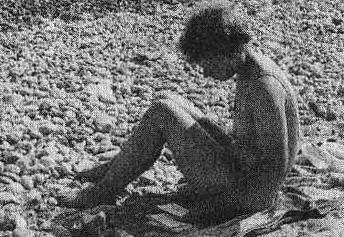

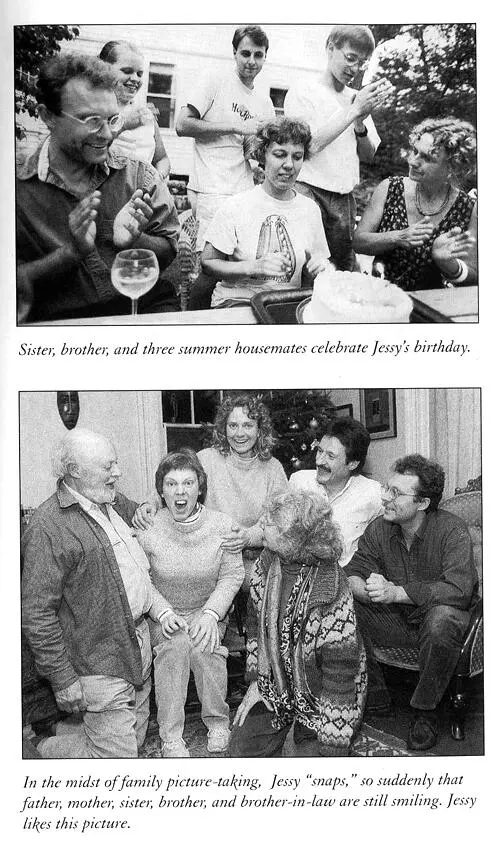
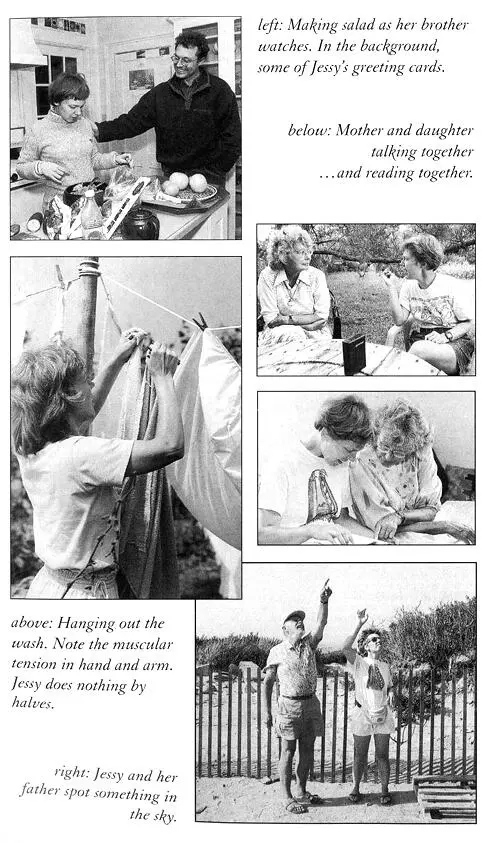
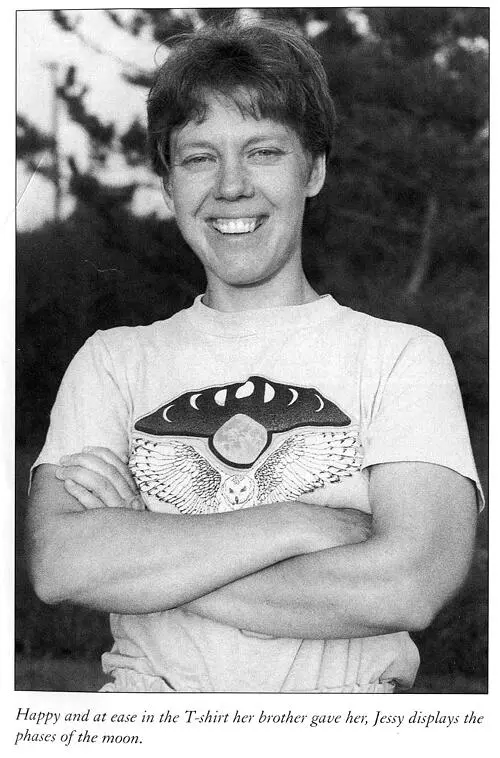
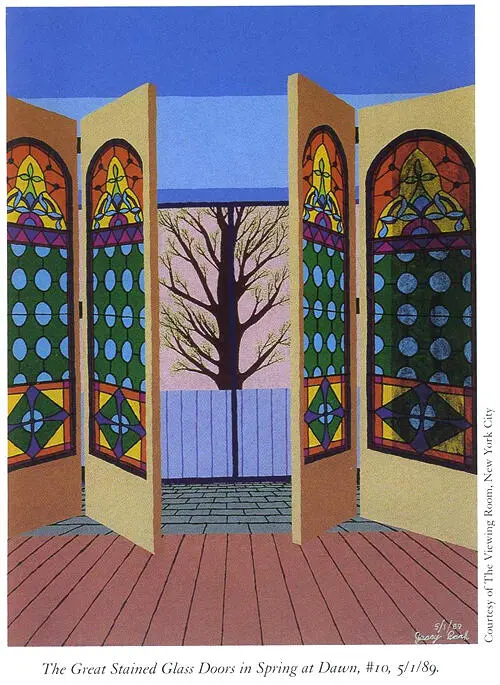
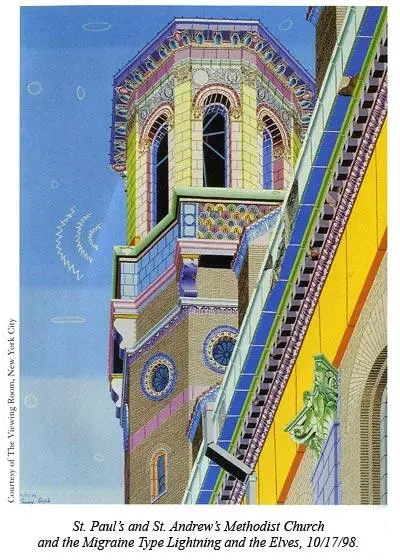


Jessy cannot tell her story for herself. Though she can speak nothing but truth and her memory is unerring, I must tell it for her, today as when she was eight years old. She has learned to read, but she will never read it. Once I was naive enough to think she might; when I wrote that account of her first eight years I changed her name to Elly so she need never be embarrassed. I know now how effortful is her reading, how partial her understanding, how questionable her embarrassment. I know too that she’d never read such a story even if she could, or understand why it might be worth the telling. So I can tell it freely, in its continuing strangeness and its increasing, precious ordinariness, as Jessy enters, more and more fully, yet never entirely, the world in which we live, all of us, together.
Appendix I
Jessy s Descriptions of Some of Her Paintings
Jessy began writing descriptions of her paintings in 1980, the year she finished school, as a way of maintaining and extending her hard- won writing skills. The first descriptions depended heavily on prompts and suggestions. Gradually she learned more and more about what a viewer might need to be told; still, it was some years before she wrote one independently. She has written her descriptions independently ever since. Though she writes a draft in pencil and asks me to look it over, only occasionally do I suggest an addition or revision in the interests of clarity. These examples are her descriptions of the paintings reproduced in color in this book.

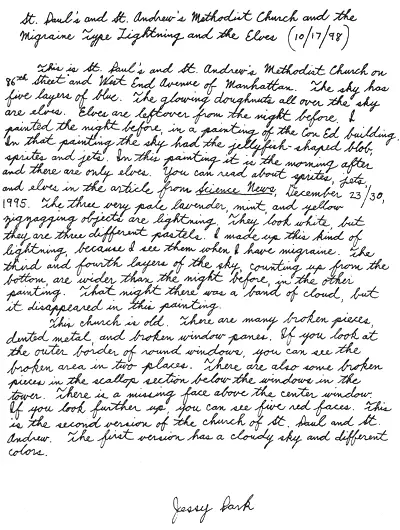
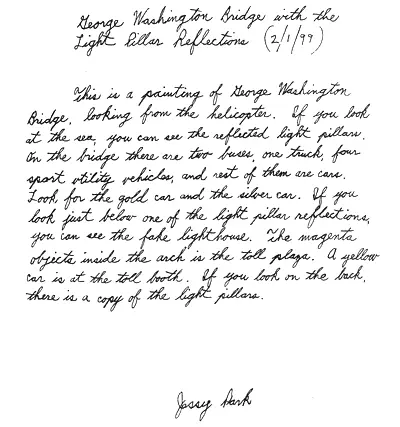
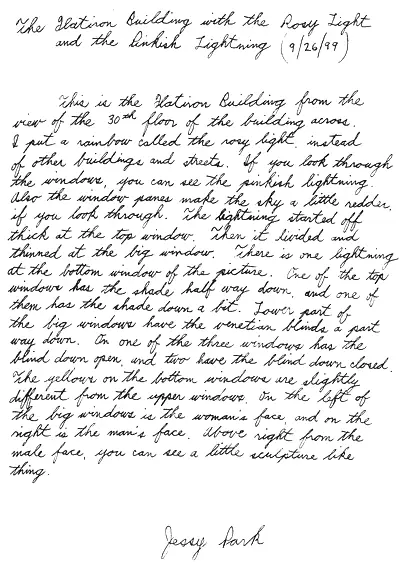
DSM IV Definition of Autism
These are the American Psychiatric Association’s diagnostic criteria for Autistic Disorder, as laid out in the Diagnostic and Statistical Manual of Mental Disorders, fourth ed. (Washington, D.C.: American Psychiatric Association, 1994), pages 70–71 and 77–78.
A. A total of six (or more) items from (1), (2), and (3), with at least two from (1), and one each from (2) and (3):
1. qualitative impairment in social interaction, as manifested by at least two of the following: a. marked impairment in the use of multiple nonverbal behaviors such as eye-to-eye gaze, facial expression, body postures, and gestures to regulate social interaction b. failure to develop peer relationships appropriate to developmental level c. a lack of spontaneous seeking to share enjoyment, interests, or achievements with other people (e.g., by a lack of showing, bringing, or pointing out objects of interest) d. lack of social or emotional reciprocity
2. qualitative impairments in communication, as manifested by at least one of the following: a. delay in, or total lack of, the development of spoken language (not accompanied by an attempt to compensate through alternative modes of communication such as gesture or mime) b. in individuals with adequate speech, marked impairment in the ability to initiate or sustain a conversation with others c. stereotyped and repetitive use of language or idiosyncratic language d. lack of varied, spontaneous make-believe play or social imitative play appropriate to developmental level
3. restricted repetitive and stereotyped patterns of behavior, interests, and activities, as manifested by at least one of the following: a. encompassing preoccupation with one or more stereotyped and restricted patterns of interest that is abnormal in intensity or focus b. apparently inflexible adherence to specific, nonfunctional routines or rituals c. stereotyped and repetitive motor mannerisms (e.g., hand or finger flapping or twisting, or complex whole-body movements) d. persistent preoccupation with parts of objects
B. Delays or abnormal functioning in at least one of the following areas, with onset prior to age 3 years:
1. social interaction, 2. language as used in social communication, or
3. symbolic or imaginative play
C. The disturbance is not better accounted for by Rett’s Disorder or Childhood Disintegrative Disorder
The association’s definitions of Asperger’s disorder and PDD-NOS (Pervasive Developmental Disorder Not Otherwise Specified) depend on the previous definition. The criteria for Asperger’s disorder are almost identical, except for the absence of „clinically significant general delay“ in „language. [or] in cognitive development or in the development of age- appropriate self-help skills, adaptive behavior (other than in social interaction), and curiosity about the environment in childhood“. PDD-NOS may be diagnosed „when there is a severe and pervasive impairment of reciprocal social interaction or verbal and nonverbal communication, or when stereotyped behavior, interest, and activities are present“ but the criteria for „atypical autism“ or another specific disorder are not met. Autism may be called atypical „because of late onset, atypical symptomatology, or subthreshold symptomatology, or all of these“.
Читать дальше
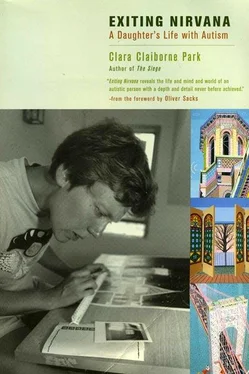













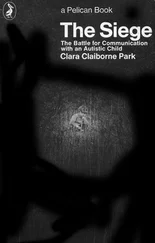

![Майкл Азеррад - Come as you are - история Nirvana, рассказанная Куртом Кобейном и записанная Майклом Азеррадом [litres]](/books/392533/majkl-azerrad-come-as-you-are-istoriya-nirvana-ra-thumb.webp)



![Эверетт Тру - Nirvana - Правдивая история [litres]](/books/399241/everett-tru-nirvana-pravdivaya-istoriya-litres-thumb.webp)




